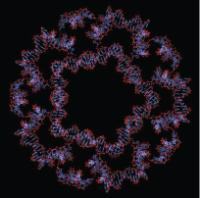
Can 20 trisoligonucleotides with 20×3 individual sequences be programmed to self-assemble into a DNA dodecahedron? The answer is yes if one starts from a new generation of trisoligonucleotides based on C3h-symmetric linkers with proper flexibility. The resulting dodecahedron has C1 symmetry and may facilitate the construction of multimodular scaffolds in the future. Credit: (C) Wiley-VCH For quite some time, DNA, the stuff our genes are made of, has also been considered the building material of choice for nanoscale objects. A team led by Günter von Kiedrowski at the Ruhr University in Bochum has now made a dodecahedron (a geometric shape with twelve surfaces) from DNA building blocks. As reported in the journal Angewandte Chemie, these objects are formed in a self-assembly process from 20 individual trisoligonucleotides, building blocks consisting of a “branching junction” and three short DNA strands.
A regular dodecahedron is a geometric shape made of 12 pentagons of equal size, three of which are connected at every vertex. This results in a structure with 30 edges and 20 vertices. In order to produce a hollow dodecahedral object from DNA, the researchers used 20 “three-legged” building blocks (three DNA strands connected together at one point). The centers of these building blocks represent the vertices of the dodecahedron. The three edges projecting from each vertex are formed when a single strand of DNA converts two neighboring bridging components into a double strand.
In order for this process to result in a dodecahedron and not some other random geometric object, all of the DNA strands must have a different sequence. Among these, there must, however, be pairs of complementary strands that can bind to each other.
By using a computer program, the researchers identified a set of 30 independent, 15-base-pair-long, double-stranded DNA sequences with similar physical properties. The double-stranded sequences were assigned to the individual edges of the dodecahedron and to specific vertices for termination. It was then determined which three single-stranded sequences needed to be attached to each three-legged junction for the predetermined structure to form.
The team synthesized the 20 computed trisoligonucleotides by means of a solid-phase synthesis. The three DNA strands were always attached by way of an aromatic six-membered carbon ring. When mixed in equal parts in a buffer solution, these building blocks do aggregate to form the expected product: regular dodecahedra. Atomic force microscopy images reveal them to be uniform particles with a diameter of about 20 nm. Under pressure, the dodecahedra are quite flexible, the can be deformed like “soft balls” without incurring any damage.
If the trisoligonucleotides are equipped with pendant “arms”, the dodecahedra can be outfitted with additional functional molecules. In this way, highly complex nanoconstructs, resembling little viruses in shape and size, should be accessible in the future. Potential applications range from medical diagnostics to nanoelectronics.
Source : Wiley-Blackwell
 Print Article
Print Article Mail to a Friend
Mail to a Friend
